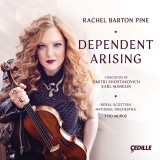Die neueste Aufnahme von Rachel Barton Pine, mit der sie das zweite Dutzend beim Label erreicht, paart das bekannte erste Konzert von Shostakovich mit einem völlig unbekannten, dem Konzert für Violine und Orchester Dependent Arising von Earl Maneeins. Damit bietet sie eine Verbindung in thematischer Anknüpfung, da Kampf, Unterdrückung und Trotz Elemente sind, die das Werk von Shostakovich ebenso prägen wie sie das Wesen von Heavy Metal Musik bestimmen.
Pine hat neben ihrer klassischen auch eine Heavy Metal Historie. So kombinierte sie einmal Heavy Metal Coversongs von mit Werken von Paganini und Ysaÿe. Beim Konzert von Earl Maneein wird klassische Musik mit Heavy Metal und Hardcore Punk verschmolzen. Sein Dependent Arising überschreitet Grenzen und schöpft Inspiration aus westeuropäischer Musiktradition, der Welt des Extreme Metal und der Praxis des Komponisten als Buddhist. Der Violinist und Komponist hat mit diesem gut halbstündigen Werk eine tragfähige und nicht nur beliebige Zusammenführung der Stile geschaffen. Klassisch aufbauend auf drei Sätzen wird im langsamen Satz zunächst überwiegend ein schwelgerischer klassischer Ton geboten, dem sich allerdings mit modernen Schlagwerkpassagen und anderen Aspekten neue Elemente anschließen. Dagegen sprechen der erste und der kurze dritte Satz eine stark rhythmisch und unruhig fundierte und mehr von anderen Stilen getragene Sprache.
Bei Shostakovich schaffen sie und das Orchester im ersten Satz durch ein dichtes und die dunklen Klangfarben hervorhebendes Spiel eine bedrohliche Anmutung. Das wirkt gerade wie eine aufziehende Gewitterfront und lässt weniger an eine friedliche Situation denken, wie sie der Satztitel Nocturne vermuten lassen könnte. Der zweite Satz, Scherzo, wird dann turbulent und rhythmisch prägnant musiziert. Hier wird das turbulente Metrum zu geradlinig und bestimmend vor die Stimmung gesetzt. In der folgenden Passacaglia lassen sie das weitausgespannte Stimmennetz des langsamen Satzes eng verwoben und ohne die Spannung aufzugeben schwingen. Markantes tiefstes Blech setzt hier Akzente neben der Geigerin, die immer weiter strebt und doch kaum Erlösung findet. Die Burlesque als Schlusssatz zeigt dann wieder Solistin und Orchester im quirligen Wirbel der Musik vereint.
Rachel Barton Pine bietet ein virtuoses Spiel, dass hier auch mit musikalischer Tiefe gepaart wird. So hebt sie bei Maneein die moderne Stilistik lustvoll hervor. Bei Shostakovich findet sie sehr viele Möglichkeiten, die in der Musik versteckten Botschaften zu charakterisieren. Etwa in der Kadenz der Passacaglia wird die quälende Situation gewusst, die sie im Kopfsatz aufgebaut hatte.
Auch der Dirigent Tito Muñoz ist ein Freund des Komponisten und so war es ein Leichtes für ihn, mit in diese Welt einzutauchen. Das Orchester musste sich vermutlich die Fachbegriffe dieser extremen Musik erst aneignen. Dafür schlägt es sich hervorragend und nimmt die Abenteuerreise gerne an. Auch im Shostakovich lässt sich das Ensemble nicht lumpen und feuert mit seinem seine eigene Wichtigkeit hervorhebenden Spiel die Geigerin immer zu neuer Intensität an und bietet nicht nur Leinwand.
Rachel Barton Pine’s latest recording, which marks her second dozen with the label, pairs Shostakovich’s familiar First Concerto with a completely unfamiliar one, Earl Maneein’s Concerto for Violin and Orchestra, ‘Dependent Arising.’ In doing so, she offers a connection in thematic tie-in, as struggle, oppression and defiance are elements that inform Shostakovich’s work just as they inform the essence of heavy metal music.
Pine has a heavy metal history in addition to her classical one. For example, she once combined heavy metal cover songs by with works by Paganini and Ysaÿe. Earl Maneein’s concert fuses classical music with heavy metal and hardcore punk. His ‘Dependent Arising’ crosses boundaries and draws inspiration from Western European musical tradition, the world of ‘extreme metal’ and the composer’s practice as a Buddhist. The violinist and composer has created a viable and not just arbitrary merging of styles with this work that lasts a good half hour. Classically based in three movements, the slow movement initially offers a mostly indulgent classical tone, though it is joined by new elements in the form of modern percussion passages and other aspects. In contrast, the first and short third movements speak a strongly rhythmic and restless tone, supported more by other styles.
In Shostakovich’s first movement, she and the orchestra create a threatening impression by playing densely and emphasizing the dark timbres. This just seems like an approaching storm front and makes one think less of a peaceful situation, as the movement title Nocturne might suggest. The second movement, Scherzo, is then played in a turbulent and rhythmically incisive manner. Here the turbulent meter is set too straightforwardly and decisively before the mood. In the following Passacaglia they let the wide-stretched voice network of the slow movement swing tightly interwoven and without giving up the tension. Striking lowest brass sets accents here alongside the violinist, who strives on and on and yet finds little redemption. The Burlesque, as the final movement, then again shows soloist and orchestra united in the lively whirl of the music.
Rachel Barton Pine offers virtuoso playing that is also paired here with musical depth. In Maneein, for example, she highlights the modern style with relish. In Shostakovich, she finds many ways to characterize the messages hidden in the music. For example, in the cadenza of the Passacaglia, the agonizing situation she had set up in the opening movement is known.
The conductor Tito Muñoz is also a friend of the composer and so it was easy for him to dive into this world with us. The orchestra probably had to learn the technical terms of this extreme music. In return, it does an excellent job and gladly accepts the adventure journey. Also in the Shostakovich the ensemble does not let itself be lumpen and fires the violinist with its own importance emphasizing play always to new intensity and offers not only screen.






















